MySQL basic use (2) DCL statements and aggregate functions
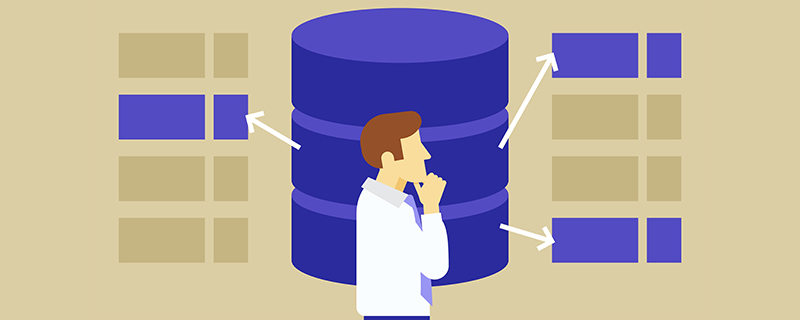
【Related learning recommendations: mysql tutorial(Video)】
DCL
DCL is relatively simple and is mainly used to grant or revoke permissions to access the database, as well as commit and rollback database transactions.
Grant/Revoke Permissions
Take granting permissions as an example. After we create a new database, we want to grant specific users access and operation permissions for the database (generally in the production environment, for the sake of security, no (will operate the database through the root user), for this we first need to create a specific user, such as test. Control-level SQL statements such as DCL are generally executed on the command line. We enter the MySQL Docker container and connect to the database. , create a new test user through the CREATE USER statement, and set the password to test:

After the creation is completed, you can see this user in the mysql.user data table:

##Host field is % means test users can connect to the MySQL server from any host.
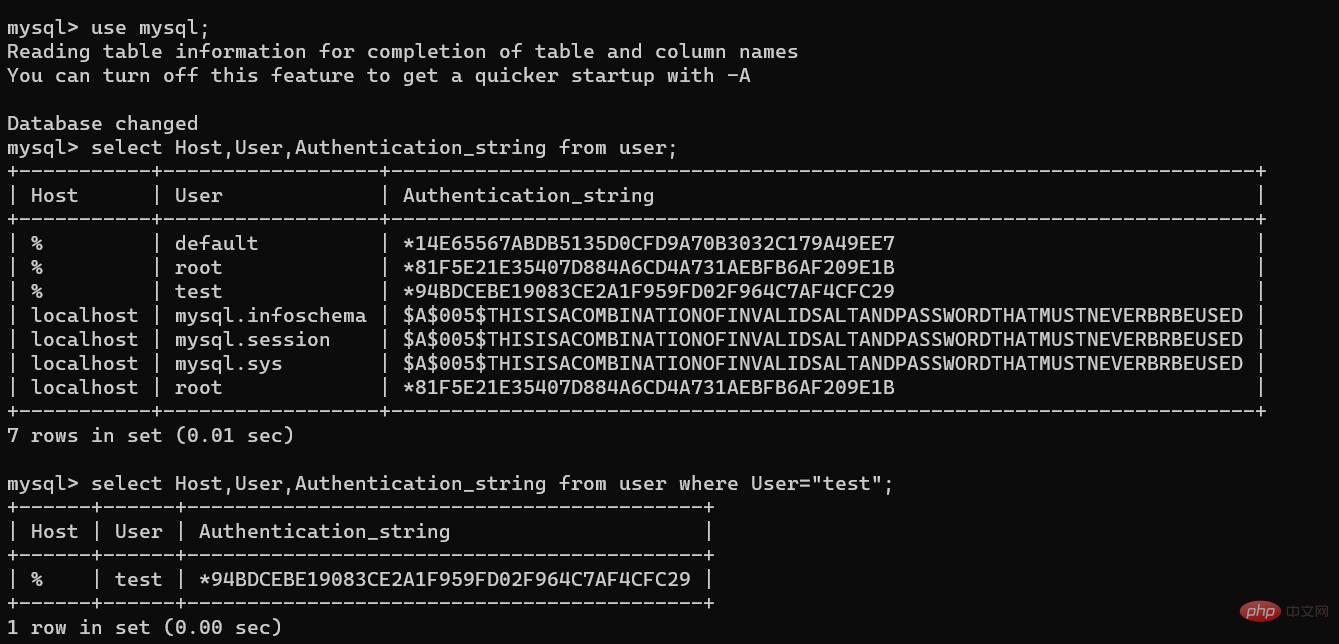
GRANT statement granttest The user has all operating permissions on the test database:

flush privileges; Refresh the permissions so that you can see this user in the permission list of the test database:

test When the user logs in, he can only see the test database because it has no operating permissions for other databases:

REVOKE statement on the command line:
1 2 |
|
1 2 3 4 5 6 7 8 9 10 11 |
|
implicit transaction.
To manually execute multiple SQL statements as a transaction, you can useBEGIN to open a transaction and use COMMIT to submit a transaction. This transaction is called Explicit transactions, if an error or exception occurs during transaction execution, the transaction can be rolled back through the ROLLBACK statement.

BEGIN statement, but during execution After multiple statements, the transaction was not submitted through COMMIT. I tested the execution of these SQL statements and entered the "Browse" panel to view it. I found that no new records were inserted:

ROLLBACK to roll back the transaction after the above SQL sequence, the effect will be the same:
1 2 3 4 5 6 |
|
COMMIT statement at the end , you can submit the modification smoothly:
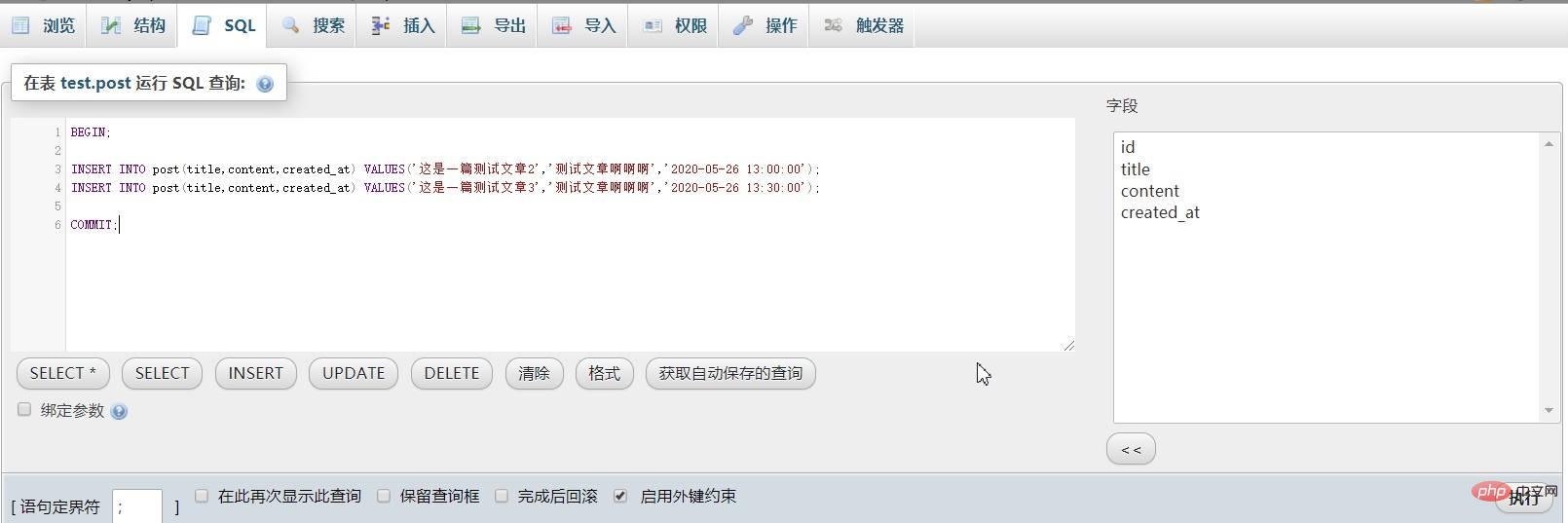

Aggregation functions
In addition to common SQL queries and operation statements, SQL also has some built-in aggregate functions to facilitate simple and convenient statistics of results during data query. Here we introduce several common functions: count, sum, avg, max and min.
COUNT
count The function can be used to count the total number of query results. This function is usually used when performing paging queries. In order to facilitate the direct viewing of the results, we demonstrate in the command line:
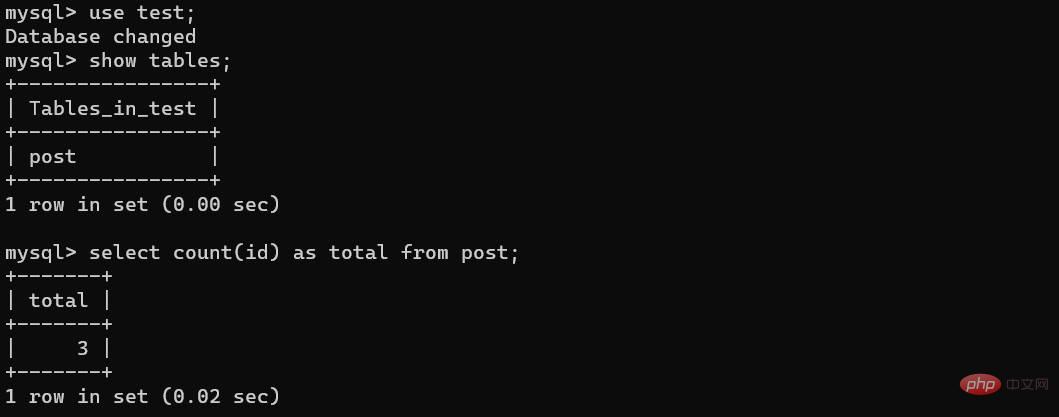
In order to improve readability when querying fields, you can specify it through as Field alias, here the post table has a total of three records, so the query result is 3.
SUM
sum can be used to sum a certain field in the statistical query results, so it can only be used for numeric type fields, here we are post A new field views is added to the table, which is used to store the number of views of the corresponding article record. In the post table structure, select to add a field after the content field and click "Execute":

Add the field The name is set to views, and its type is set to UNSIGNED INT, which represents a non-negative integer. At the same time, the default value is set to 0. The corresponding SQL statement can be passed Preview function view:
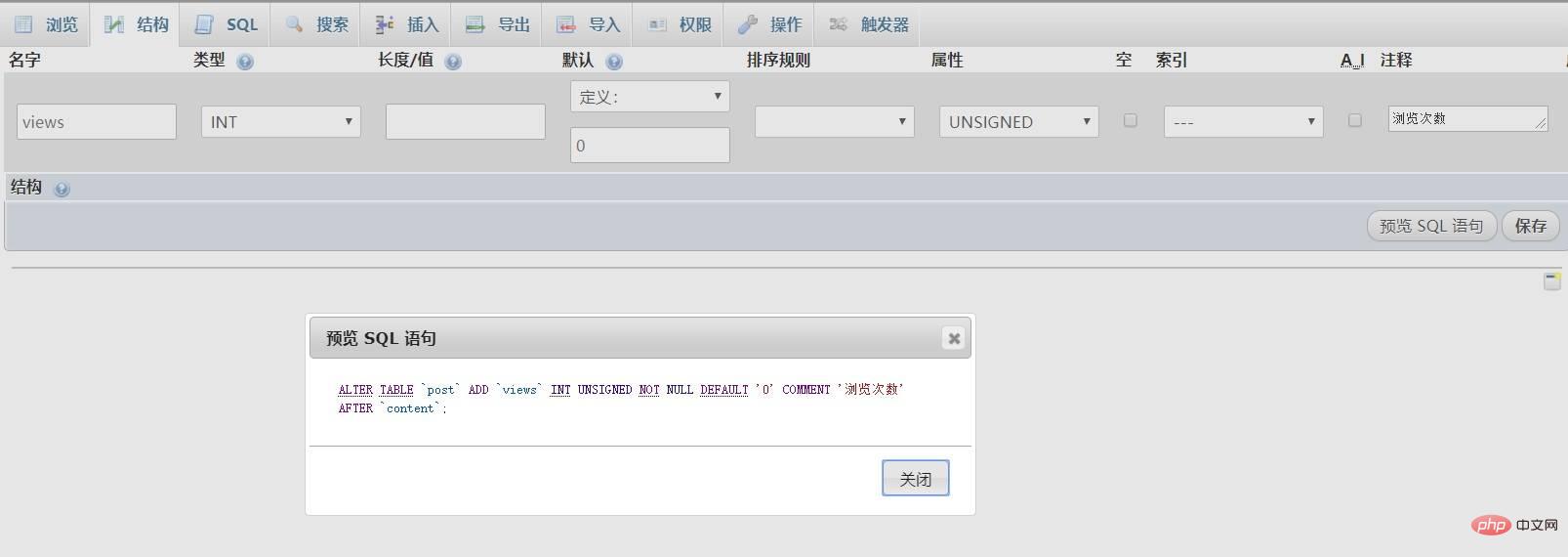
#Click "Save" to create this field, and you can see it in the table structure:

Since views has a default value, the views value of all records currently is 0:

can be passed " Edit" function to set it to the corresponding simulation value:

Next, we can sum the results through the sum function:
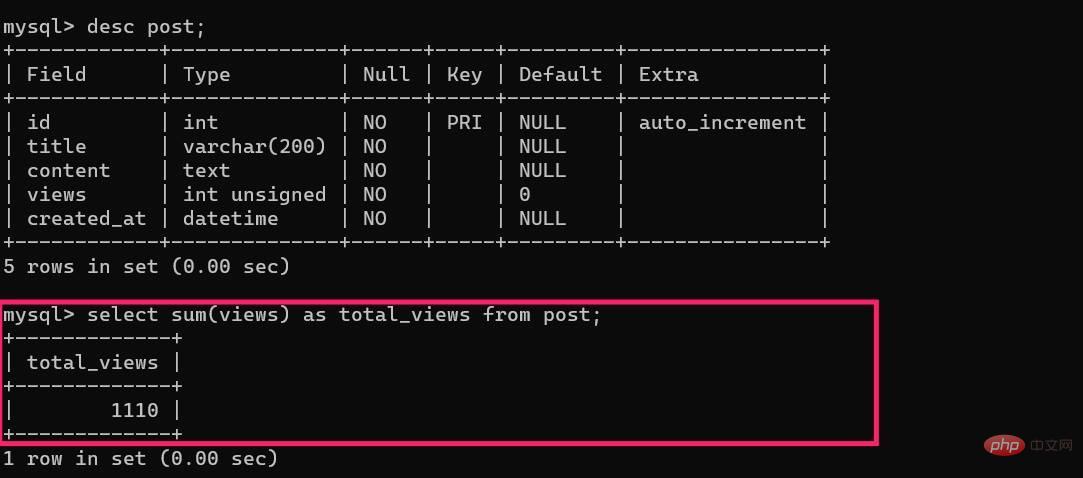
avg can be used to count the average value of a field in the query results, and sum The same applies to numeric type fields. For example, we can use it to count the average number of views of all articles:

max can be used to get the maximum value of a numeric field in the query results. For example, to get the article information with the highest number of views, you can do this:
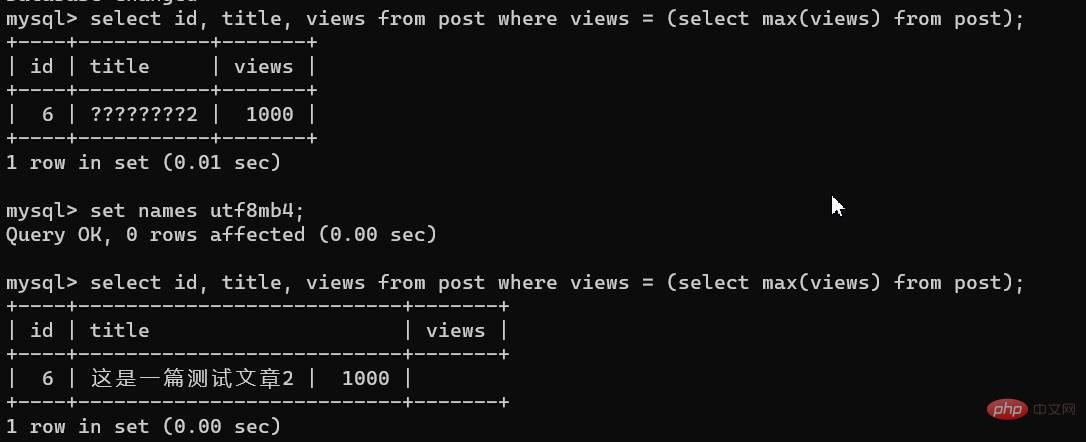
utf8mb4 through set names utf8mb4;, so that it works normally Chinese and Emoji emoticons are displayed.
subquery is also used here, which is to use the result of one query as the condition of another query. Here we pass the maximum number of views to the parent as the result of the subquery Query is used as the query condition to obtain the corresponding article information.
MINRelative tomax, the min function is used to obtain the minimum value of a numeric type field in the query results, such as to obtain the browse The article information with the lowest number can be done like this:

For more related articles, please pay attention tophp mysql Column!
The above is the detailed content of MySQL basic use (2) DCL statements and aggregate functions. For more information, please follow other related articles on the PHP Chinese website!

Hot AI Tools

Undresser.AI Undress
AI-powered app for creating realistic nude photos

AI Clothes Remover
Online AI tool for removing clothes from photos.

Undress AI Tool
Undress images for free

Clothoff.io
AI clothes remover

Video Face Swap
Swap faces in any video effortlessly with our completely free AI face swap tool!

Hot Article

Hot Tools

Notepad++7.3.1
Easy-to-use and free code editor

SublimeText3 Chinese version
Chinese version, very easy to use

Zend Studio 13.0.1
Powerful PHP integrated development environment

Dreamweaver CS6
Visual web development tools

SublimeText3 Mac version
God-level code editing software (SublimeText3)

Hot Topics
 MySQL: An Introduction to the World's Most Popular Database
Apr 12, 2025 am 12:18 AM
MySQL: An Introduction to the World's Most Popular Database
Apr 12, 2025 am 12:18 AM
MySQL is an open source relational database management system, mainly used to store and retrieve data quickly and reliably. Its working principle includes client requests, query resolution, execution of queries and return results. Examples of usage include creating tables, inserting and querying data, and advanced features such as JOIN operations. Common errors involve SQL syntax, data types, and permissions, and optimization suggestions include the use of indexes, optimized queries, and partitioning of tables.
 How to learn oracle database
Apr 11, 2025 pm 02:54 PM
How to learn oracle database
Apr 11, 2025 pm 02:54 PM
There are no shortcuts to learning Oracle databases. You need to understand database concepts, master SQL skills, and continuously improve through practice. First of all, we need to understand the storage and management mechanism of the database, master the basic concepts such as tables, rows, and columns, and constraints such as primary keys and foreign keys. Then, through practice, install the Oracle database, start practicing with simple SELECT statements, and gradually master various SQL statements and syntax. After that, you can learn advanced features such as PL/SQL, optimize SQL statements, and design an efficient database architecture to improve database efficiency and security.
 MySQL's Place: Databases and Programming
Apr 13, 2025 am 12:18 AM
MySQL's Place: Databases and Programming
Apr 13, 2025 am 12:18 AM
MySQL's position in databases and programming is very important. It is an open source relational database management system that is widely used in various application scenarios. 1) MySQL provides efficient data storage, organization and retrieval functions, supporting Web, mobile and enterprise-level systems. 2) It uses a client-server architecture, supports multiple storage engines and index optimization. 3) Basic usages include creating tables and inserting data, and advanced usages involve multi-table JOINs and complex queries. 4) Frequently asked questions such as SQL syntax errors and performance issues can be debugged through the EXPLAIN command and slow query log. 5) Performance optimization methods include rational use of indexes, optimized query and use of caches. Best practices include using transactions and PreparedStatemen
 Why Use MySQL? Benefits and Advantages
Apr 12, 2025 am 12:17 AM
Why Use MySQL? Benefits and Advantages
Apr 12, 2025 am 12:17 AM
MySQL is chosen for its performance, reliability, ease of use, and community support. 1.MySQL provides efficient data storage and retrieval functions, supporting multiple data types and advanced query operations. 2. Adopt client-server architecture and multiple storage engines to support transaction and query optimization. 3. Easy to use, supports a variety of operating systems and programming languages. 4. Have strong community support and provide rich resources and solutions.
 How to connect to the database of apache
Apr 13, 2025 pm 01:03 PM
How to connect to the database of apache
Apr 13, 2025 pm 01:03 PM
Apache connects to a database requires the following steps: Install the database driver. Configure the web.xml file to create a connection pool. Create a JDBC data source and specify the connection settings. Use the JDBC API to access the database from Java code, including getting connections, creating statements, binding parameters, executing queries or updates, and processing results.
 How to start mysql by docker
Apr 15, 2025 pm 12:09 PM
How to start mysql by docker
Apr 15, 2025 pm 12:09 PM
The process of starting MySQL in Docker consists of the following steps: Pull the MySQL image to create and start the container, set the root user password, and map the port verification connection Create the database and the user grants all permissions to the database
 MySQL's Role: Databases in Web Applications
Apr 17, 2025 am 12:23 AM
MySQL's Role: Databases in Web Applications
Apr 17, 2025 am 12:23 AM
The main role of MySQL in web applications is to store and manage data. 1.MySQL efficiently processes user information, product catalogs, transaction records and other data. 2. Through SQL query, developers can extract information from the database to generate dynamic content. 3.MySQL works based on the client-server model to ensure acceptable query speed.
 Laravel Introduction Example
Apr 18, 2025 pm 12:45 PM
Laravel Introduction Example
Apr 18, 2025 pm 12:45 PM
Laravel is a PHP framework for easy building of web applications. It provides a range of powerful features including: Installation: Install the Laravel CLI globally with Composer and create applications in the project directory. Routing: Define the relationship between the URL and the handler in routes/web.php. View: Create a view in resources/views to render the application's interface. Database Integration: Provides out-of-the-box integration with databases such as MySQL and uses migration to create and modify tables. Model and Controller: The model represents the database entity and the controller processes HTTP requests.






